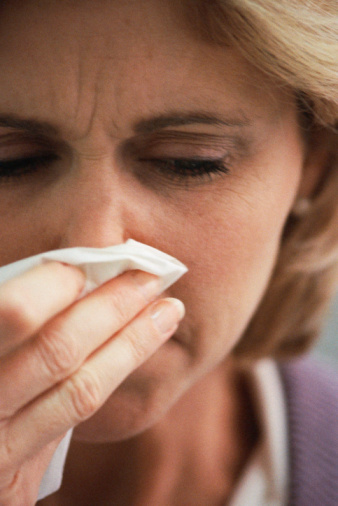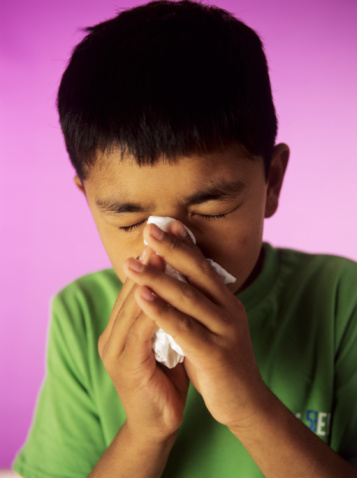Sinusitis
Sinusitis (sometimes known as rhino-sinusitis since the sinus cavities by default affect and usually cause inflammation of the nose) is inflammation of the sinuses which may or may not lead to infection.
Sinusitis is often caused by allergies or allergic reaction, but may also result from autoimmune issues, bacterial infection, fungal infection, or viral infection.
Ninety percent of adults are deemed to have experienced sinusitis at some point during their lives.
The sinus cavities affected by sinusitis are dubbed the “paranasal sinuses”, and consist of the frontal sinuses, sphenoid sinuses, maxillary sinuses, the anterior ethmoid sinuses, and the posterior ethmoid sinuses. The anterior and posterior ethmoid sinuses are divided by the lamella of the middle turbinate, which is located in the nasal cavities.
Recent research on sinusitis seems to signify that the condition is often linked to those who suffer from asthma as well as a host of other secondary conditions, likely due to the inflammation of the nose which occurs, and as part of a series of conditions which affect the airway. As the respiratory tract is affected, sinusitis is often accompanied (in addition to infection) by a cough, wheezing, post-nasal drip, sore throat, etc.
Sinusitis is characterized by health providers as being acute, sub-acute, or chronic in terms of duration. It is one of the most commonly experienced conditions amongst adults in the United States and internationally.
Sinusitis? Get Remedies Fast!
Symptoms

The most common complaint from those who suffer from sinusitis is a feeling of pain or ‘pressure’ where sinus cavities are located: behind the eyes, around the eyes, sides of the face, and/or a toothache caused by pressure from sinus cavities located behind the jaw.
This is also widely described as an intense headache, a dull, constant aching with pressure where the affected sinuses are located.
The pressure may increase or decrease when a person sits, stands, or otherwise moves their head. Pain for sinusitis can, and often does, exist only on one side of the face where the affected sinus cavities are located.
Other symptoms of sinusitis which often occur in tandem in various combination are nasal discharge, itchy eyes and nose, runny nose or congestion, toothache, post nasal drip, sore throat, cough, fever, noticeably poorer breath, and localized pain above the eyebrows, around the eyes, sides of the face, where the blocked or infected sinuses are located.
As allergic reactions vary by individual, this is not a complete list, but merely a list of the most common symptoms experienced with sinusitis.
If nasal discharge is clear, the condition is typically diagnosed as being a result of chronic sinusitis. If, however, the nasal discharge is yellow or green in tinge, either a viral or bacterial infect ion may be present. Acute sinusitis develops rapidly
Causes
Acute sinusitis is often caused by a virus, bacteria, suffers of a recent or current cold, or exposure to abnormal causes of nasal pressure changes such as scuba diving. Rarer causes include fungus and the spread of an infected tooth. Due to the correlation between acute sinusitis sufferers who contract the symptoms due to a cold, management of cold symptoms as quickly as possible is recommended.
The most common cause of chronic sinusitis is allergies or allergic reactions due to allergies. When the sinus cavities become blocked or clogged, air cannot circulate properly, which leads to inflammation and often infection.
Chronic sinusitis also can be compounded due to virus or bacteria, and is actually a systemic condition wherein acute sinusitis is experienced regularly. Chronic sinusitis sufferers often experienced increase facial pressure and pain due to an ongoing condition.
Asthma and the presence of nasal polyps or a deviated septum are also common causes of chronic sinusitis. Dehydration may also be a factor if a patient has been dehydrated long term. Individuals with severe allergies often experience sinusitis as a result of symptoms stemming from exposure to allergens.
Risk Factors

Those who suffer from allergies are highly likely to experience sinusitis at some point, if not chronically, due to inflammation caused by allergens. People who have recently experienced a cold or virus which has affected the upper respiratory system and/or nasal passages are also at an elevated risk.
Asthma sufferers are also at a high risk for developing sinusitis, and are often chronic sufferers. Asthma often leads to a cyclical pattern with sinus problems, similar to those with allergies.
Until the sinusitis is treated, the asthma will not improve, and vice versa. For this reason, as many preventative measures as possible are recommended to individuals who also suffer from asthma.
Those with a deviated septum and weakened immune system are at a heightened risk of not only sinusitis, but of infections developing as a result due to the inability of the body to fight or manage the symptoms efficiently.
People who suffer from problems with cilia in their nose working correctly can also be at a heightened risk for sinusitis, as cilia functions to filter air before it enters the nasal cavities.
Prevention Tips
Treatment for allergies to stop the development of sinusitis is the best initial prevention. Avoid any allergens that might trigger inflammation, such as air pollutants, cigarette smoke, pet dander, dust, etc. If needed, take over the counter or prescription medication to manage the symptoms.
As one of the most common complications of sinusitis is the development of a sinus infection, it’s also important, especially for chronic sufferers, to attempt to maintain a healthy lifestyle to support their immune system as much as possible.
Drinking plenty of water, eating fruits and vegetables regularly rich in antioxidants, and regular exercise contribute to overall wellness and will help to shorten the span of infection or help to prevent it. As increased stress levels are associated more and more with a weakened immune system, stress reduction should also be considered as a preventative measure.
Some chronic sufferers of sinusitis also report that using a humidifier is beneficial to prevent the sinuses from becoming too dry, and subsequently blocked or clogged, as a preventative measure.
Individuals suffering from sinusitis, sinus pressure, or infection should take extreme caution in using air travel for transportation as the pressurized cabins can lead to increased facial pain, headaches, and other complications of the sinuses as a result.
Testing and Diagnosis Considerations
If this is the first time an individual has experienced symptoms, it is important to go for a health care provider for diagnosis, as many symptoms commonly associated with migraines can be misdiagnosed by patients as sinus problems.
If chronic sinusitis persists, testing for allergies is very common and extremely beneficial for sufferers. Once
the allergic triggers have been identified via testing, the patient is in a better position to manage exposure to allergens and subsequently treat and manage allergies, reducing instances of sinusitis completely or gradually in the process.
A CT scan of the head is often required by health care providers to evaluate or diagnose recurring sinusitis.
Sinusitis is categorized by health care professionals in terms of duration as acute, sub acute, and chronic. Acute sinusitis is characterized by lasting less than four weeks (often developing rapidly); sub acute sinusitis, four to eight weeks; chronic sinusitis is categorized as symptoms lasting eight weeks or more.
Types of Sinusitis
Once the duration of the sinusitis symptoms are determined, health practitioners can further classify sinusitis by the sinus cavities which are affected. Maxillary sinusitis can cause pressure and pain in the cheek area, a headache, or a toothache.
Frontal sinusitis is characterized by a headache, pain or pressure in the frontal sinus cavities behind and above the eyes. Ethmoid sinusitis (anterior and posterior) consists of pain, pressure, or a headache between or behind the eyes where the ethmoid sinus cavities are located. Sphenoid sinusitis also is characterized by pressure behind the eyes, but in a different capacity, often affected by the vertex of the head.
Left untreated, sinusitis can develop into a severe infection, bronchitis, and/or other upper respiratory complications, in addition to being extremely painful.
Treatment Options
A mild case of sinusitis can often be treated using ibuprofen or other anti-inflammatory pain medication, over the counter sinus medication, or prescription medications used to manage allergies. However, as many sufferers of sinusitis have chronic problems, other treatment options in varying degrees of intensity are recommended.
As allergies are the main cause of sinusitis, treatment for allergies to stop the development of sinusitis is the best initial prevention. Chronic allergy sufferers often depend on prescription medication in the form of nasal sprays, oral antihistamines, and other homeopathic treatments (for instance elderberry or use of a sinus cleanser, such as a neti pot) to manage their condition.
Prescription nasal sprays usually have active ingredients of mild steroids to reduce inflammation of the nose and nasal passages. Over the counter sprays are not recommended for long term use as their effectiveness is extremely short term and they are known to have addictive properties.
Allergy Shots
Allergy shots are used as a treatment option for individuals who still suffer from symptoms after treatment using the above combination of prescription antihistamines, nasal sprays, and over the counter medications. Administered by an allergist or ENT, allergy shots are given weekly or bi-weekly to improve a patient’s resistance to allergens, reducing the severity and duration of symptoms long-term.
As a result of the growing concern over the use of antibiotics to treat infectious disease, homeopathy is very popular, especially in Europe, for combating and treating sinusitis. Herbs to boost the immune system such as echinacea, or those rich in antioxidants such as green tea, are commonly used for prevention or treatment. Patients have also reported success with the use of elderberry extract, which has been proven to strengthen the body’s resistance to infection.
Neti Pot
A low-cost option with an unusual method of application but high degree of patient and doctor satisfaction is the use of a neti pot. Neti pots use water to irrigate the sinus cavities through the nose and proper positioning of the head, helping to clear out potential irritants, reduce inflammation, and reduce clogging. A saline solution is often used within the neti pot to ensure it is sterile. Caution must be taken when using these popular devices as improper placement of the head could lead to ear infection, increased pressure, or other complications.
If a deviated septum is deemed to be the cause of recurring sinusitis by an ENT (Ear, Nose, and Throat specialist) or healthcare provider, a septoplasty, or surgery to correct the deviation, may be necessary in order to prevent future instances of the disease or reduce severity. This is often a highly effective option for people who are routinely having their daily routines interrupted throughout the year as a result of chronic sinusitis. While costly, this procedure is often covered with documentation by health insurance, and has a high rate of patient satisfaction.
Surgery
Surgery to remove nasal polyps, if they are deemed to exist, or to enlarge openings in the sinus cavities is often common as a treatment for patients on whom other forms of treatment (including allergy shots, prescription nasal sprays ,and oral medications) have reduced efficacy.
Treatment for sinus infection as a result of sinusitis includes a regimen of antibiotics, prescribed by a health care provider. Viral sinus infections cannot be treated with antibiotics and must be evaluated on an individual basis for treatment.
Cost of Prevention and Treatment
Treatment costs can range from low-end (such as over the counter medication, use of at home nasal irrigation), to mid-range for ongoing prescription treatments and sprays (sometimes mitigated by coverage from health insurance). Allergy shots are another moderate cost treatment option.
Surgery is by far the most expensive treatment for sinusitis, reserved for chronic sufferers. However, the initial cost of surgery may prove to be cost effective in the long term, especially if patients have a reduced need for treatment or preventative measures after surgery.

No Comments